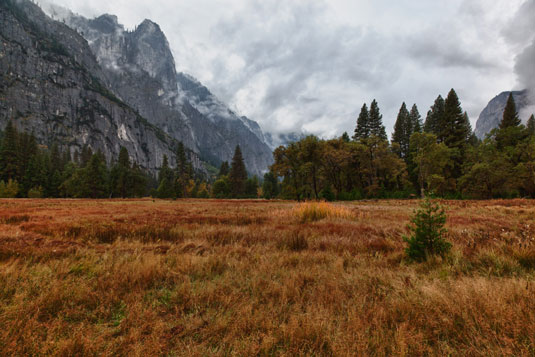When a thick blanket of clouds blocks the sun, this is flattering light for photographing landscapes and wildlife. The light is wonderfully diffuse and there are virtually no shadows. When the clouds start forming, grab your camera gear and use the tips in this section to capture some wonderful photographs.
If the cloud layer is relatively thin, you’ll be able to capture images with a relatively small aperture (large f-stop value). If the clouds are thick, you’ll have to use a larger aperture (smaller f-stop value) or increase the ISO setting. Your other alternative is to place the camera on a tripod.
When photographing landscapes on a cloudy day, you still want to use a fairly small aperture to ensure a large depth of field. If the light is very dim, you can get a decent depth of field with a wide-angle lens if you use an f-stop value of f/8.0. This beats increasing the ISO any day.
You can increase depth of field by focusing on an object that is two-thirds of the way in your scene. When you focus partway into a scene, the background remains sharp because of the wide-angle lens and the relatively small aperture.
If the clouds are in conjunction with an incoming storm, you have all the ingredients for a compelling and powerful photograph. Use the brooding clouds as part of your composition.
When you photograph a scene on a cloudy day with clouds that are drifting in and out of view, your camera may get a bit wonky when calculating the exposure. Look at the histogram to make sure you don’t have any blown-out highlights. If you do, use exposure compensation to lower the exposure, and then take the picture again.
If you photograph a scene that has subtle changes of tone in the clouds (see the figure), take three exposures and blend them using an HDR application.

When you take photographs on a cloudy day, use exposure compensation to decrease exposure by 1/3 EV (Exposure Value). This increases the saturation of the colors in the photograph.
Another tool that’s useful on a cloudy day is a UV or polarizing filter. Either filter can help cut through any haze to make distant objects clearer. Another filter that’s useful is a skylight filter, which also cuts through haze and warms the image slightly.
Cloudy days are great for photographing wildlife. The soft shadowless light captures fine detail like beaks, feathers, and eyes. If you photograph a bird in bright afternoon sunlight, harsh shadows hide some of the details that make your fine-feathered friend photogenic. The same rule holds for any wildlife. When your goal is to get photos of wildlife with good details, cloudy days are better than bright afternoon sun.
When you use filters on wide-angle lenses, you may see a vignette (dark area) at the edges of the image. This is because the angle of view is so wide that your camera actually captures part of the filter ring. The solution — albeit not a cheap one — is to purchase filters with a narrow ring. The alternative is to remove the vignette in an image-editing application that has this feature.

